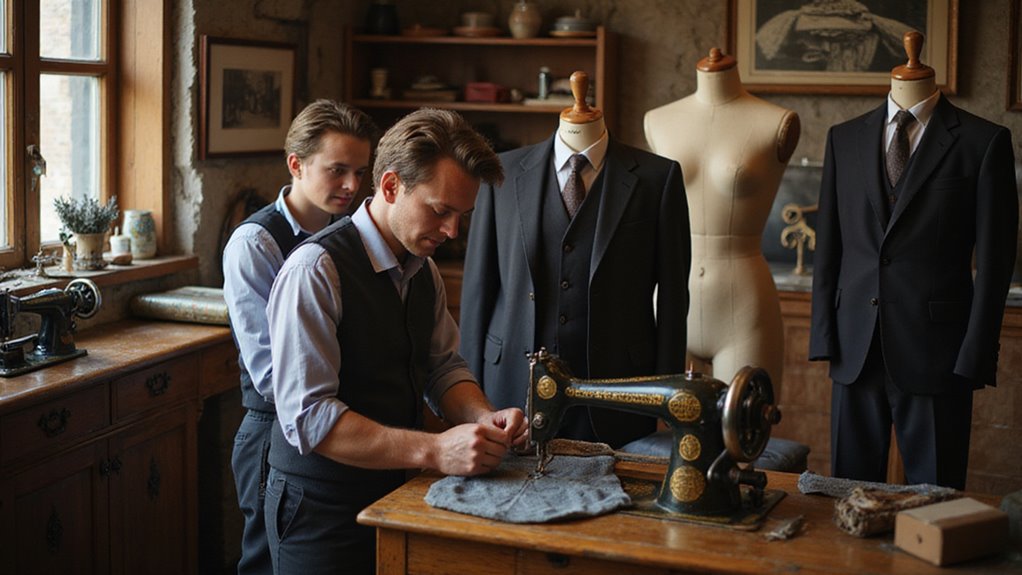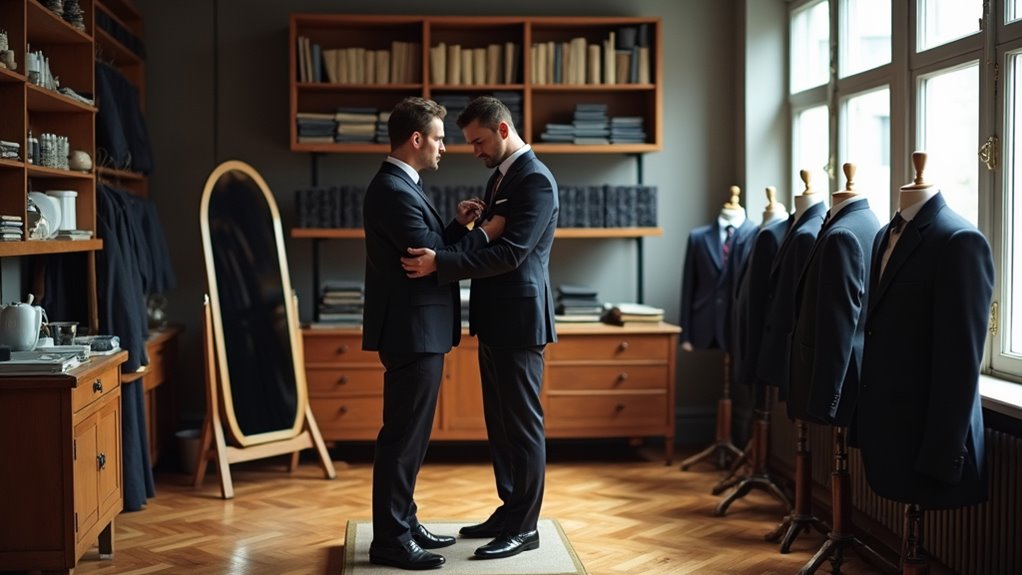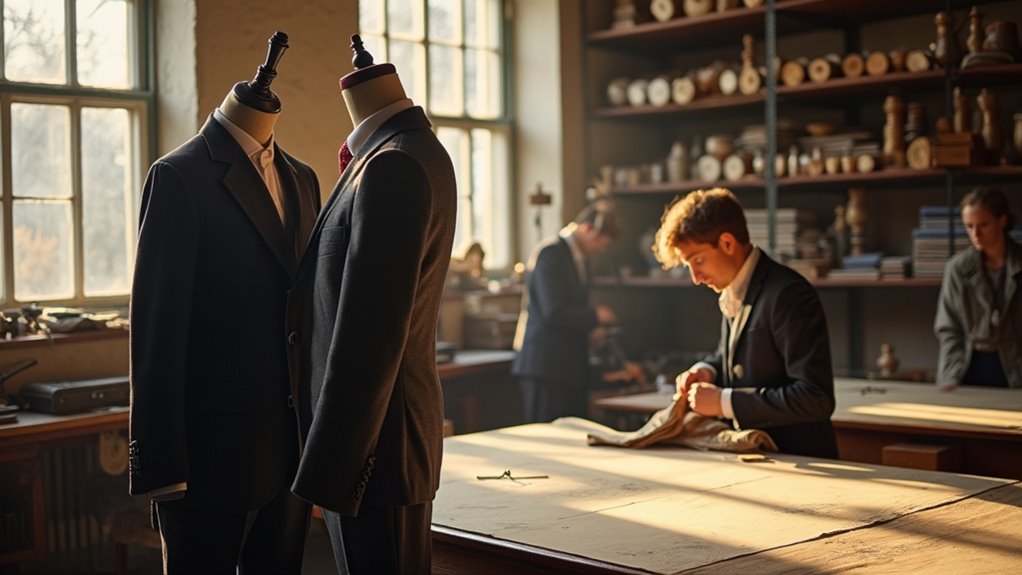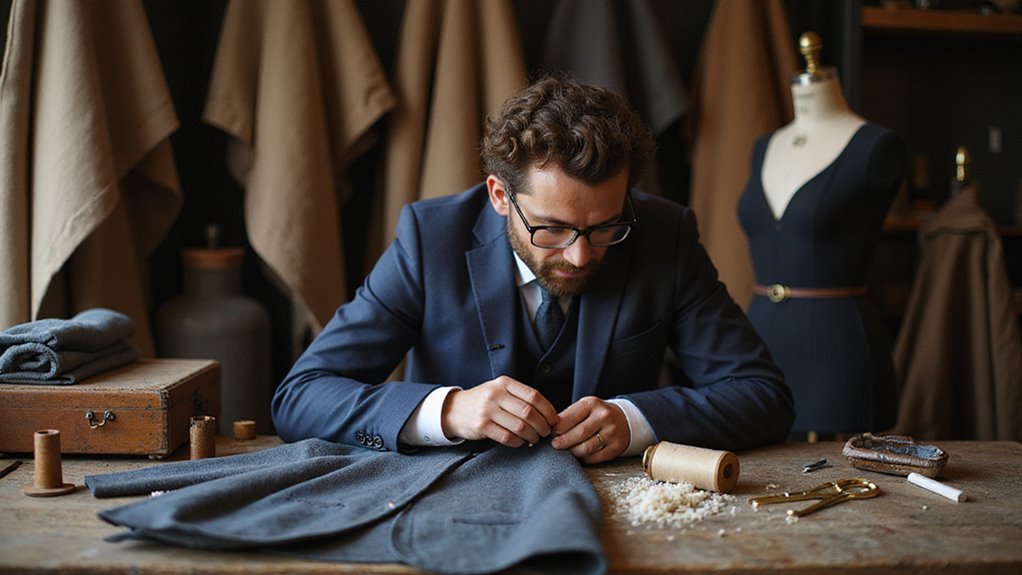Many people struggle to find suits that fit well and reflect their style. Off-the-rack options often feel generic and uncomfortable. Even made-to-measure suits can fail to capture the wearer’s personality or body shape. This leaves customers frustrated and disappointed with their wardrobe choices.
These issues often lead to wasted money and time. People settle for clothes that don’t match their needs. They lose confidence in their appearance and avoid special occasions. The promise of a perfect fit seems out of reach for most shoppers.
The real difference between bespoke and made-to-measure tailoring is the unmatched personalization and craftsmanship that bespoke offers.
Bespoke tailoring creates a unique suit just for you. It solves fit and style problems with expert attention to detail. This blog will guide you through the differences so you can choose the best option for your needs.
Key Takeaways
- Bespoke tailoring shops create custom garments using unique patterns, precise measurements, and multiple fittings for each client.
- Renowned shops like Henry Poole & Co., Rubinacci, and Ascot Chang are known for exceptional craftsmanship and tradition.
- Clients can personalize every detail, including fabric, lining, lapel style, and buttons, to achieve a unique look.
- The bespoke process typically takes 4–8 weeks, involving fabric selection, pattern drafting, fittings, and finishing.
- Superior fit, high-quality materials, and hand-stitched detailing justify the higher cost of bespoke tailoring shops.
The History of Bespoke Tailoring

Bespoke tailoring means making clothes to fit one person exactly. This craft became famous in 18th-century London, especially on Savile Row. Tailors there measured each customer carefully before making any clothes. They used special patterns and hand sewing to ensure a perfect fit. If you wanted a suit, you would choose fine fabrics like wool, silk, or cashmere. Each fabric was checked for quality and texture before use.
Tailors cut and sewed each piece by hand to match your body shape. In the 19th century, custom tailoring shops grew more popular and earned strong reputations. Unlike custom suits, bespoke tailoring involves creating a new pattern from scratch for every client, which allows for the highest level of personalization and craftsmanship. If you visit a bespoke tailor today, you will still see these careful methods in use. Many bespoke shops also offer guidance on choosing between waistcoat vs vest styles to match your needs and the occasion.
Key Differences Between Bespoke and Made-to-Measure
You’ll notice stark contrasts in the measurement and fitting process, with customized involving dozens of precise fittings and made-to-measure relying on standard templates. In tailored, your pattern emerges from scratch, tailored to every contour, while made-to-measure adjusts an existing base.
This distinction extends to fabric selection and detailing, where custom opens a wider spectrum of personalization. With bespoke tailoring, multiple fittings ensure the suit is crafted to an impeccable fit, reflecting both body nuances and individual style. The evolution of women’s suits demonstrates how bespoke tailoring remains at the forefront of comfort, adaptability, and timeless elegance.
Measurement and Fitting Process
The measurement and fitting process is how a garment is sized and shaped for you. Custom tailoring uses careful measurements to match your body. Tailors note details like shoulder shape, posture, and differences between your sides. They record many measurements to make sure the garment fits you well. This process also helps with choosing fabric and style options.
Bespoke tailoring uses several in-person fittings for small changes. Made-to-measure tailoring uses fewer fittings and starts with standard patterns. Bespoke focuses on your unique body, while made-to-measure adjusts existing templates. Each measurement affects how the fabric fits and moves on you. If you want the best fit, consider how many fittings each method offers.
Pattern Creation Methods
Pattern creation is how a garment’s shape is designed for each person. In custom tailoring, a master cutter drafts a unique pattern from scratch for every client. This pattern includes every curve and posture of your body. If you have asymmetry, the pattern adjusts for it. Made-to-measure uses a standard template and changes it for your size. This limits how closely the garment fits your body.
Your chosen fabric is then cut by hand to match your unique pattern. Cutting the fabric requires skill, because small mistakes affect the fit. In bespoke tailoring, pattern creation combines careful measurement and technical knowledge.
Level of Personalization
Custom tailoring offers more personalization than made-to-measure garments. If you want full control, choose custom tailoring. Custom options let you pick any fabric, including durable and comfortable materials. You can decide lapel width, pocket style, lining, and button placement.
If you like direct input, you can work closely with skilled tailors. They use up-to-date techniques to ensure a perfect fit. Made-to-measure uses standard patterns with fewer choices. Custom tailoring ensures your suit fits well and feels comfortable every day.
The Art of Taking Precise Measurements
You’ll need a tailor’s tape, straight edge, and precise chalk to capture every contour before fabric ever meets scissors. Maintain a natural posture, as slouching or tensing can throw off even the most careful measurements. Watch for common errors like uneven shoulder readings or misjudged sleeve lengths, since a fraction of an inch can affect the drape and fit of fine cloth.
Referencing key measurements for shirt fitting is essential to ensure your results are both accurate and replicable. Using high-quality, detailed images in your design process ensures lifelike accuracy when translating measurements into digital or mockup presentations.
Essential Measurement Tools
Accurate measurement tools are necessary for well-fitting clothes. Even small mistakes can change how fabric looks and fits. Use proper tools to make sure each measurement is correct. The basic tools include:
- Flexible measuring tape: This tape bends around curves for exact chest, waist, hip, and inseam measurements.
- Tailor’s square or L-square: These help you draw clear angles for shoulders and hems on any garment.
- Seam gauge: This tool marks short, repeated distances for tasks like hemming or making pleats.
If you use good tools, your measurements will be reliable on all types of fabric.
Body Posture Importance
Body posture changes how well your clothes fit during custom tailoring. If you stand differently, measurements may be inaccurate. An upright, relaxed stance helps tailors mark the right spots on your body. Proper posture means shoulder seams, sleeves, and trouser lines fall where they should. Good alignment also makes movement easier and supports comfort.
| Posture Factor | Tailoring Impact |
|---|---|
| Upright Shoulders | Correct shoulder width |
| Relaxed Arms | Accurate sleeve length |
| Even Weight Balance | Even side seams |
| Neutral Spine | Smooth jacket drape |
| Level Hips | Balanced trouser rise |
Maintaining good posture helps tailors create the best custom fit.
Common Measurement Errors
Common measurement errors often lead to poor garment fit. Mistakes in measuring can make seams pull or fabric drape unevenly. If you want accurate results, you must avoid these common errors. Every inch matters when measuring for custom clothing.
Here are three frequent measurement mistakes to watch for:
- Tape slackness can cause incorrect measurements if the tape is too loose or too tight.
- Improper stance during measuring may hide your real shape, which affects fit in jackets or trousers.
- Layer interference happens if you measure over bulky clothes, making the final fit too loose.
Selecting the Perfect Fabric
Choosing the right fabric is key for a good suit. Fabric affects how the suit looks and how long it lasts. Wool is a strong choice if you need durability. High-twist blends resist daily wear if you use the suit often. Lightweight fabrics like worsted wool feel cool and drape well.
Heavy flannel gives extra warmth and structure if it is cold. Always check the weave for evenness; this shows good quality. Using custom tuxedo mockups can help clarify design concepts and minimize costly mistakes before the final fabric is cut.
Color choice matters for style and use. Navy and charcoal are safe for most settings. Green or checked fabrics add some personality without being too bold. Hold the fabric in natural light to see its true color. Pick a fabric that fits the purpose. If you need a business suit, go for classic colors.
For events, you can choose something more eye-catching. The right fabric shapes both comfort and impression. If you want to preview your fabric and design choices before committing, you can use a tuxedo mockup PSD to visualize how different colors and textures will look in a realistic setting.
Understanding the Fitting Process

You’ll start with a precise measurement consultation, where every contour and posture nuance informs the cut of your chosen fabric. Throughout multiple fitting sessions, the tailor refines each seam and drape, adjusting for the fabric’s behavior on your frame. This process ensures your garment achieves a flawless balance of structure, comfort, and style.
Utilizing visual communication during the fitting process can help illustrate potential design choices and adjustments before committing to the final cut. Accurate measurement techniques—such as using a soft tape and measuring the natural waistline—are essential to avoid common fitting mistakes and guarantee a perfect result.
Initial Measurement Consultation
The initial measurement consultation is the first step to create your custom garment. A tailor takes accurate measurements of your body. These include your shoulders, chest, waist, and hips. You also discuss your fabric preferences and how you care for your clothes. This helps the tailor recommend materials that fit your needs. The process is detailed to ensure your garment fits well.
Here is what happens during the consultation:
- The tailor records every important measurement for a perfect fit.
- You look at fabric samples and learn about their feel and care needs.
- The tailor asks about your daily routine and climate to suggest the best fabric and design.
Multiple Fitting Sessions
Fitting sessions help tailor your suit for a perfect fit. You try on a basic version with loose seams. The tailor checks how the fabric fits your body during each session. They look at the balance, sleeve angle, and how the fabric hangs from the shoulders.
If changes are needed, the tailor adjusts the suit. Usually, two or three sessions are enough. These steps make sure each seam and edge fits you well. If you want a suit that fits perfectly, you need these fitting sessions.
Personalization Options for Every Client
Custom tailoring offers many ways to personalize clothing for each client. A tailor adjusts every detail to suit your body and lifestyle. If you have specific needs, a tailor can suggest options that improve comfort and durability.
You get personal service at every step of the process. With advances in virtual fitting technology, clients can now preview how their tailored pieces will look and fit before any fabric is cut.
- Fabric Selection: You can pick strong wool for everyday wear or soft cashmere for luxury. Each fabric affects how long clothes last.
- Styling Details: You may choose lapel size, pocket shape, and button type. These details help show your personal taste.
- Lining Choices: You could select silk for a bright look or cotton for breathability. Both options add comfort and style.
Using realistic display tools like mockups can also help you visualize and approve tailoring choices before the final garment is made.
The Role of the Master Tailor

A master tailor leads every step of making custom clothes. They check fabric for strength, weight, and drape before cutting. If the fabric passes inspection, the master tailor marks and cuts it based on the client’s exact measurements. Patterns are drawn with care to fit the client correctly. Hand-stitching and careful pressing shape the garment. Each detail, such as shoulder angle or sleeve position, is adjusted for comfort and style.
The master tailor ensures the final piece looks good and lasts a long time. Increasingly, some bespoke tailoring shops utilize realistic suit design visualization to preview how a garment will look before cutting, helping both tailor and client make confident design decisions. In recent years, advances in 3D suit design have enabled tailors to offer interactive previews and streamline the customization process for their clients.
Timelines: From First Consultation to Final Garment
The process starts with a consultation where you meet the tailor and choose your fabric. Choices about fabric and workshop schedules affect the total time. If you want the best results, the timeline usually runs four to eight weeks.
First, you and the tailor look at fabric samples and select one that fits your needs. Next, the tailor creates a pattern just for you and arranges an initial fitting. If you need changes, the tailor adjusts the pattern for better fit and comfort.
Finally, the garment is assembled and carefully checked for quality. If all adjustments are done, the finished garment is delivered to you. Many clients use this time to consider rolling up shirt sleeves as a way to personalize the final look and transition seamlessly between formal and casual styles.
Craftsmanship Techniques That Set Bespoke Apart

You’ll notice the difference immediately in hand-stitched buttonholes, sharp lapel edges, and seamless linings crafted by skilled artisans. Each garment starts with traditional pattern drafting, measured precisely to your unique posture and silhouette. You also select from curated fabrics, ensuring texture, weight, and color are matched to your specifications.
Hand-Stitched Precision Details
Hand-stitched precision means each stitch is made by hand for better quality. Tailors use this method to improve a garment’s fit and durability. Every hand-made stitch adds flexibility and strength to the clothing. If you look at a jacket’s lapel, you will see small, even stitches along the edge.
Here is what makes tailored details unique:
- Hand-Picked Edges: Tailors shape the lapel edges for a sharp and defined look.
- Milanese Buttonholes: Silk thread is used for buttonholes, making them strong and neat.
- Invisible Seam Reinforcement: Extra stitching inside the garment protects areas that get the most wear.
These careful methods give custom clothes a long life and a stylish finish.
Traditional Pattern Drafting
Traditional pattern drafting means making clothing patterns by hand, not machines. A tailor takes careful measurements of your body. These measurements are marked onto paper or fabric with chalk. The pattern follows your shoulders, chest, waist, and hips. If you have unique posture or body shapes, the pattern adjusts for them. This process gives you a fit that matches only you.
A master cutter needs skill to match fabric designs across seams and pockets. If the patterns do not align, the garment looks less professional. Careful pattern making shows respect for the customer and their needs. When a pattern is made from scratch, your clothes fit better and look neater. If you want comfort and a sharp style, traditional drafting is a reliable choice.
Individualized Fabric Selection
Fabric gives a garment its unique look and feel. In custom tailoring, choosing fabric is your first important step. You will touch fabric samples and check their thickness and material. Each choice changes how the garment looks and lasts.
- Fabric durability: Strong fabrics last longer and resist damage from daily use.
- Color matching: Matching fabric color to your skin and clothes creates a balanced appearance.
- Weave structure: Different weaves, like twill or plain, give the garment specific textures and drapes.
Good fabric selection shapes the garment’s comfort and style. Custom garments always begin with the right fabric choice.
Caring for Your Custom Garments

Custom garments need special care to last. Each piece uses unique fabrics and careful construction. You should follow care steps that fit your garment’s material. Use a soft brush to remove dust and protect the fabric. Hang jackets on broad, shaped hangers to keep their form. Air out garments after wearing, but avoid direct sunlight. If you rotate your clothes, you help prevent stress on seams. When cleaning is needed, use a dry cleaner that knows how to care for custom clothing.
| Fabric Type | Storage Tip | Cleaning Method |
|---|---|---|
| Wool | Store in cedar wardrobe | Dry clean gently |
| Linen | Use fabric covers | Wash by hand in cold water |
| Silk | Use padded hangers | Dry clean professionally |
| Cotton | Fold with acid-free paper | Wash in gentle cycle |
| Velvet | Lay flat in a drawer | Use a specialist dry clean |
Common Myths About Bespoke Tailoring
Bespoke tailoring is often misunderstood because of common myths. Many people think it is only about style and luxury. In reality, it is a technical process focused on fit and fabric quality.
Bespoke suits are not fragile or weak. Tailors use strong fabrics and reinforce seams for daily use. Clients can pick details like buttons, linings, and stitching. If you have preferences, your tailor will listen and include them.
Customer reviews are often reliable. Many people describe how their suits fit and last over time. If you want quality and comfort, bespoke tailoring can deliver both.
The Cost of Bespoke: Is It Worth It?
A bespoke suit often costs more because it offers better fit, quality, and durability than ready-made options. You pay for expert tailoring, careful measurements, and high-quality materials. If you want a suit that lasts longer, bespoke is a strong choice. Artisans select durable fabrics and stitch each seam by hand. This adds strength and helps the suit keep its shape. Transparent pricing shows you the cost of each material and hour of labor. Here is a simple comparison:
| Feature | Off-the-Rack |
|---|---|
| Fabric Durability | Basic blends |
| Construction | Machine-stitched |
| Pricing | Fixed, less detail |
| Feature | Bespoke |
| Fabric Durability | Premium, long-wear |
| Construction | Hand-stitched |
| Pricing | Clear, itemized |
A bespoke suit is not just clothing. It is an investment in quality and skill.
Sustainable Practices in Bespoke Tailoring
Sustainable practices in bespoke tailoring focus on reducing environmental impact. Many tailor shops now use eco-friendly methods. They often choose fabrics like organic cotton, bamboo, or recycled wool.
These materials are better for the environment and still feel luxurious. Shops use dyes that require less water and produce fewer toxins. Pattern cutting is done carefully to reduce fabric waste.
If a shop uses these methods, it helps protect the planet. Customers who value sustainability can choose such shops with confidence.
Iconic Bespoke Tailoring Shops Around the World
Famous tailoring shops are known for their skill in making custom clothes. Henry Poole & Co. on Savile Row uses careful stitching and strong fabrics. Rubinacci in Naples picks top-quality cashmere and linen for each jacket. Their tailors make sure every seam is strong and neat.
Ascot Chang in Hong Kong chooses crisp cottons and silks for comfort and durability. If you want a suit that lasts, these shops are reliable choices. Their attention to detail keeps customers coming back for the perfect fit and lasting quality.
Conclusion
If you want clothing that fits perfectly, bespoke tailoring is the ideal choice. Custom tailoring shops focus on your specific measurements and preferences. This ensures each garment is both comfortable and unique.
When you choose a personalized shop, you receive individual attention from skilled tailors. If you value quality and detail, this experience will exceed your expectations. Every stitch and fabric is selected to match your style.
If you are ready to enhance your wardrobe, consider starting with a custom mockup. This helps you visualize your perfect garment before it is made. Visit a bespoke tailoring shop and begin your journey toward personalized elegance.


No Comment! Be the first one.